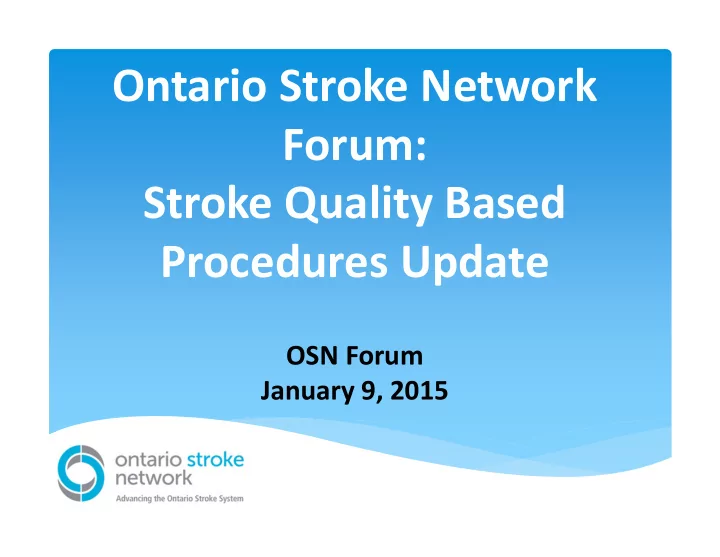

Ontario Stroke Network Forum: Stroke Quality Based Procedures Update OSN Forum January 9, 2015
Review of Objectives • Discuss & provide an update on QBP pricing, indicators and implementation plans • Provide an update on MoH Stroke Capacity Planning • Share lessons learned from 3 IDEAS Case studies in phase 1 stroke QBP implementation • Introduce phase 2 QBP handbook & obtain input on approach to further communication & engagement • Discuss strategy to address QBP implementation knowledge gaps & evaluation • Provide extensive opportunity for attendees Q&A • Support networking & facilitate information sharing
Materials In advance: • Agenda KGH QBP Impact Analysis • • Stroke QBP FAQ’s Today: • Agenda • Speaker Bios Meeting Follow ‐ up • Evaluation Survey with presentations • Proceedings report – attendee list
Agenda 1040 ‐ 1215: Phase 1 QBP Pricing, Indicator & Stroke Capacity Planning Update • QBP Analysis Case Study • Response to FAQ’s/discussion an advancing QBP implementation & pricing • Status update on indicators • Update on MoH Stroke Capacity Planning 1215 ‐ 1245: LUNCH 1245 ‐ 1345: IDEAS Stroke QBP Implementation Case Studies • Reducing Stroke Door ‐ to ‐ Transfer Times – Champlain LHIN • Stroke Capacity Assessment and Best Practice Implementation – SW LHIN • Providing greater Rehab Intensity – MH LHIN 1345 ‐ 1400: Introduction to Phase 2 Stroke QBP Clinical Handbook 1400 ‐ 1445: Addressing QBP implementation knowledge gaps & evaluation 1445 ‐ 1455: LHIN Perspectives 1455 ‐ 1500: Meeting outcomes, evaluation and wrap ‐ up ‐ C. O'Callaghan
QBP Implementation It would seem that increasing payment for high ‐ quality care is an obvious way to improve value in health care, however: • Evidence of the effectiveness of P4P in improving health care quality is mixed, without conclusive proof that these programs either succeed or fail. • Experience with P4P in health care and other settings shows that these programs are hard to design. The best combination of performance measures, organizational level of accountability, criteria for payment, and incentive size is not obvious, and unintended consequences are common. Andrew M. Ryan and Rachel M. Werner. October 9, 2013
Some of the Challenges • Most P4P systems focus on processes, rather than outcomes, which may (a) reward providers with poorer outcomes, & (b) unintentionally deter innovation and experimentation that could achieve better outcomes. • Measures only available for a subset of the processes important to good outcomes; which may divert attention from other important processes. • Providing incentives based on outcomes can create incentives to exclude or under ‐ treat patients who are likely to have poor outcomes , or to over ‐ treat patients who are likely to have better outcomes • Because of the fragmentation of care, it is often difficult or impossible to clearly assign responsibility for performance or lack of performance to a particular provider H. D. Miller, Creating Payment Systems to Accelerate Value ‐ Driven Health Care: Issues and Options for Policy Reform, The Commonwealth Fund, September 2007
What is needed? The existence of: • Categories of Dx & patient severity for which payment levels can be consistently established; • Guidelines for care for each category of Dx & patient severity; • Estimates of the cost to providers of following guidelines for care in an efficient manner; • Performance measures for each category of Dx & patient severity • Methods of collecting & reporting on performance measures H. D. Miller, Creating Payment Systems to Accelerate Value ‐ Driven Health Care: Issues and Options for Policy Reform, The Commonwealth Fund, September 2007
What is needed? Uncertainty exists due to the fact that thorough evaluations have been not been conducted therefore next steps: • payment demonstration projects must be developed, implemented, and evaluated • a wide variety of payment demonstrations are needed. Just as experimentation & evaluation is a hallmark of EBM, experimentation & evaluation is needed in order to develop the most effective cure for the ills of the payment system • support for the development, evaluation, and replication of regional payment demonstrations H. D. Miller, Creating Payment Systems to Accelerate Value ‐ Driven Health Care: Issues and Options for Policy Reform, The Commonwealth Fund, September 2007
The Good News! • Shared purpose & collaboration • Local, RSN, LHIN & provincial leadership • National BP’s • Moving cautiously on implementing final pricing • Data availability and quality are being addressed • Performance reports and benchmarks are available o LHIN Report Cards + Progress Reports, MoH baseline reports • Significant progress is being made – focus on quality & increased efficiency o Significant improvements in process & outcome indicators o IDEAS • Focus on KTE • OSN SPOR demonstration Project – QBP evaluation
Recommend
More recommend